by the Selectors of the Pratt Collection Management Department
Click the cover to reserve your copy now!
New Fiction Titles
New Nonfiction Titles
New Graphic Novel Titles
Thank you to all the people who participated in the Adult Summer Challenge this year! We loved all your reviews, including these:
 Lorraine M. (Central Library) on The Accomplished Guest by Ann Beattie: Thirteen short stories—compelling, intuitive, sentient, and full of irony.
Lorraine M. (Central Library) on The Accomplished Guest by Ann Beattie: Thirteen short stories—compelling, intuitive, sentient, and full of irony.
Yvonne B. (Forest Park Branch) on Luther: The Life and Longing of Luther Vandross by Craig Seymour: Seymour offers a poignant biography of gifted singer Luther Vandross. […]So many of us related to his music and continue to enjoy it. His music is timeless. In my opinion, Seymour’s treatment is sensitive and respectful of Vandross’ insistence on privacy.
Sandra F. (Herring Run Branch) on The Magic Strings of Frankie Presto by Mitch Albom: What impact do we have on the lives of others and what impact do they have on our lives? While The Magic Strings of Frankie Presto is a work of fiction, it does address this. It makes you think about all the interactions you have with individuals and “the bands” you join. A thoroughly wonderful read!
Daryl M. (Light Street Branch) on Railsea by China Miéville: Fun take on a post-corporapocalyptic future with trains gone wild.
Kelly M. (Light Street Branch) on Camino Island by John Grisham: Thoroughly enjoyed this. Not as much legal focus as in his previous books. I found myself rooting for both the good guys and some of the bad guys. Blew through it in a few short days–perfect vacation/summer weekend read.
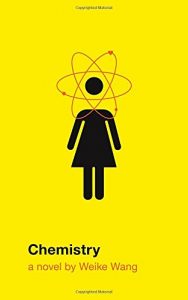
![]() Laurel B. (Govans Branch) on Chemistry by Weike Wang: An advanced chemistry student finds herself unable to advance in her work, her love life and her relationship with her parents. Using what, at times, seems like the borrowed language of English, this daughter of immigrant Chinese parents is never at a loss for words when describing the beauties, mysteries and motivations of science. Her manipulation of language is more exploratory and ultimately new than her manipulation of scientific possibilities. As the bonds of her world break down and re-form, it is her growing ability to communicate, teach and analyze her past that leads to new discoveries. First-time novelist Weike Wang gives us a concise but far-reaching exploration of expectations and unquantifiable human relationships. Equal parts dark and light, Chemistry is a worthy experiment.
Laurel B. (Govans Branch) on Chemistry by Weike Wang: An advanced chemistry student finds herself unable to advance in her work, her love life and her relationship with her parents. Using what, at times, seems like the borrowed language of English, this daughter of immigrant Chinese parents is never at a loss for words when describing the beauties, mysteries and motivations of science. Her manipulation of language is more exploratory and ultimately new than her manipulation of scientific possibilities. As the bonds of her world break down and re-form, it is her growing ability to communicate, teach and analyze her past that leads to new discoveries. First-time novelist Weike Wang gives us a concise but far-reaching exploration of expectations and unquantifiable human relationships. Equal parts dark and light, Chemistry is a worthy experiment.
Leslie J. (Roland Park Branch) on Trans-Sister Radio by Chris Bohjalian: Great book. Couldn’t put it down. Very applicable with trans in the military and recent NPR story on a trans child. Love this author! Fantastic storyteller and amazing ability to weave together the lives/stories of the parents, child, and the new relationship.
 Eleanor H. (Staff) on Simply in Season by Mary Beth Lind and Cathleen Hockman-Wert: This cookbook very ably answers the question of what to do with all those tomatoes, squash, etc., that looked so good at the grocery or farmer’s market.
Eleanor H. (Staff) on Simply in Season by Mary Beth Lind and Cathleen Hockman-Wert: This cookbook very ably answers the question of what to do with all those tomatoes, squash, etc., that looked so good at the grocery or farmer’s market.
Kelsey H. (Staff) on The God of Small Things by Arundhati Roy: This story is dazzling, disturbing, and full of lush sensory details. Not for someone who needs a linear narrative or a clear line between reality and memory. Beautifully swirled and looped.
Did you participate in the Summer Challenge? Tell us what you thought.
Youth survey – Kids or teens, what did you think?
Family survey – For caregivers and their kids.
Adult survey – Quick survey for adult individuals.
This summer, more than 9,350 readers and learners of all ages joined us for the Summer Challenge!
We’ve loved sharing books, activities, and special guests with you.
During the Summer Challenge:
Children logged over 80,350 days of reading and learning activities.
Teens logged over 17,345 days of reading and library program attendance.
Adults read over 4,100 books.
Pratt staff read over 650 books.
Over 18,000 people of all ages attended library programs.
Our most borrowed books were:
Children:
Pokemon Adventures manga series by Hidenori Kusaka
Diary of a Wimpy Kid series by Jeff Kinney
Green Eggs and Ham by Dr. Seuss
Teens:
Naruto manga series by Masashi Kishimoto
Dragon Ball Z manga series by Akira Toriyama
The Book Thief by Markus Zusak
Adults:
The Underground Railroad: A Novel by Colson Whitehead
Hillbilly Elegy : A Memoir of a Family and Culture in Crisis by J.D. Vance
All the Light We Cannot See: A Novel by Anthony Doerr


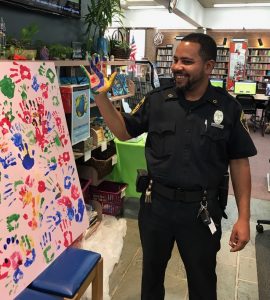
Building A Better World Together closing party community art project at the Light Street Branch.

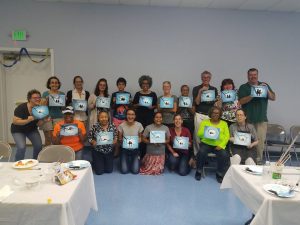
Shots from the Govans Branch closing party.


The Brooklyn Branch ended Summer Challenge with an Ice Cream Social.
Please share what you enjoyed most about the Summer Challenge this year and what would make it even better. Your honest feedback will help us to improve.
The Special Collections Department provides access to the Library’s unique and historically significant documents, rare books, and ephemera. You can find manuscripts, prints, photographs, posters, post cards, greeting cards, 19th century travel books, the history of wine and beer, the history of printing and lots more. The treasures are endless. Michael K. Johnson, Manager, Special Collections, selected three rare astronomy books to highlight before the solar eclipse on August 21, 2017.
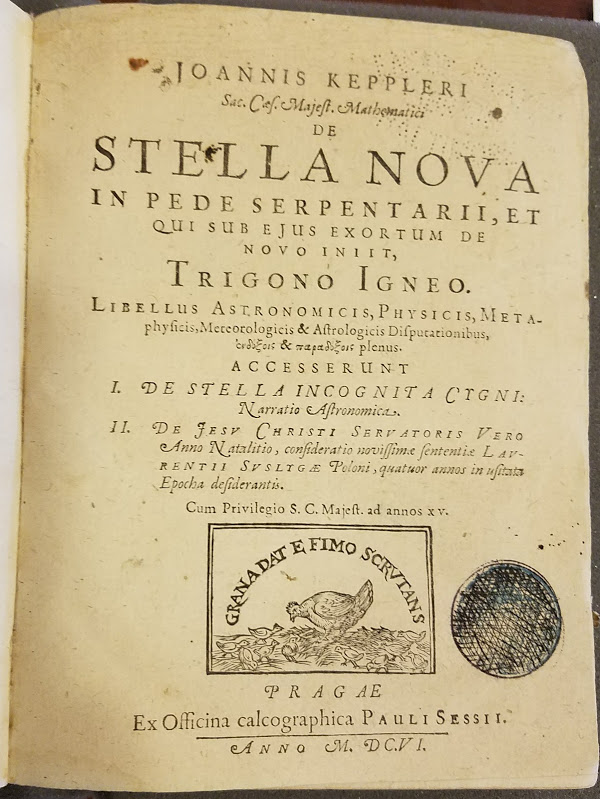
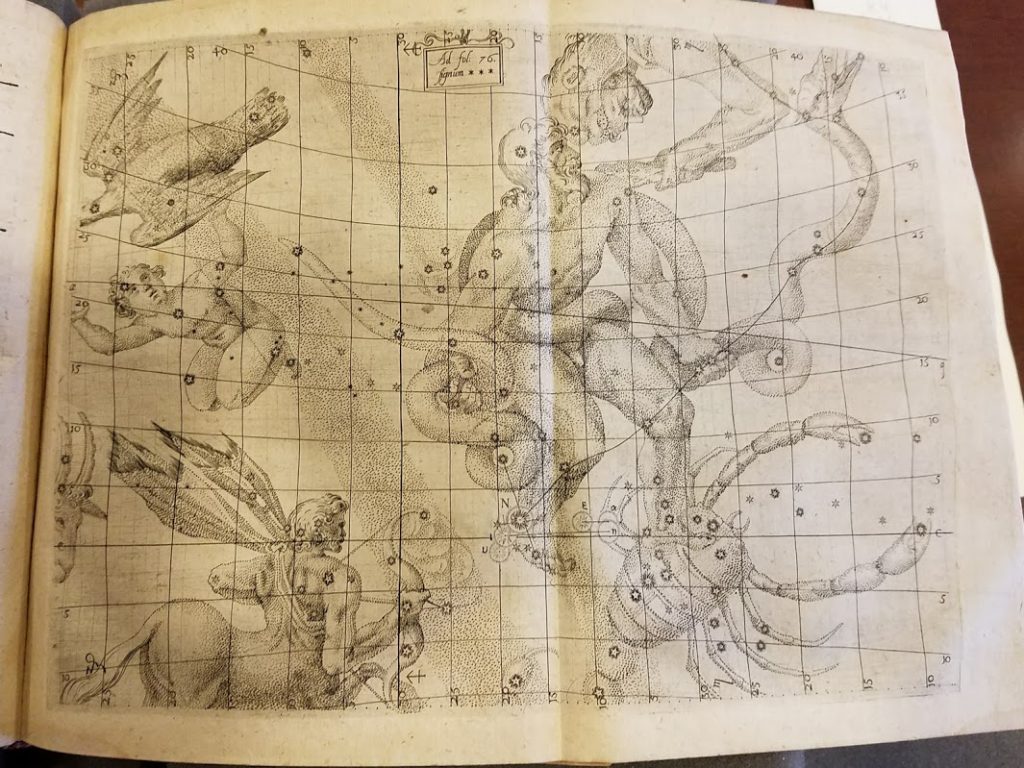
First, there is Johannes Kepler’s De Stella nova in pede Serpentarii (On the New Star in Ophiuchus’s Foot– Published in Prague, 1606). Kepler was a German Astronomer best known for the laws of planetary motion. Kepler documented the explosion of a supernova in 1604, which was the last such event observed in our Milky Way galaxy and would later be known as “Kepler’s supernova.” It is about 20,000 light years away from earth. An illustration in the book locates Kepler’s supernova in the foot of the Ophiuchus constellation.
Kepler’s star map shows the constellations of Ophiuchus (the Serpent Handler), Sagittarius and Scorpius. The Milky Way runs diagonally down from the left, and the “ecliptic,” or annual path of the Sun, runs horizontally through Sagittarius and Scorpius. A triple conjunction of Jupiter and Saturn took place in 1603, followed by a planetary massing with Mars in 1604. After the planetary massing, a “Nova” or bright star (“N”) suddenly appeared in the ankle of Ophiuchus on October 10, 1604. The new star was no ordinary star; it remained visible even in the daytime sky for over a year. The new star prompted widespread debate about what it might portend and whether the heavens could change. Now called Kepler’s nova, it was the second supernova to be observed in a generation. No supernova within the Milky Way galaxy has been observed since.
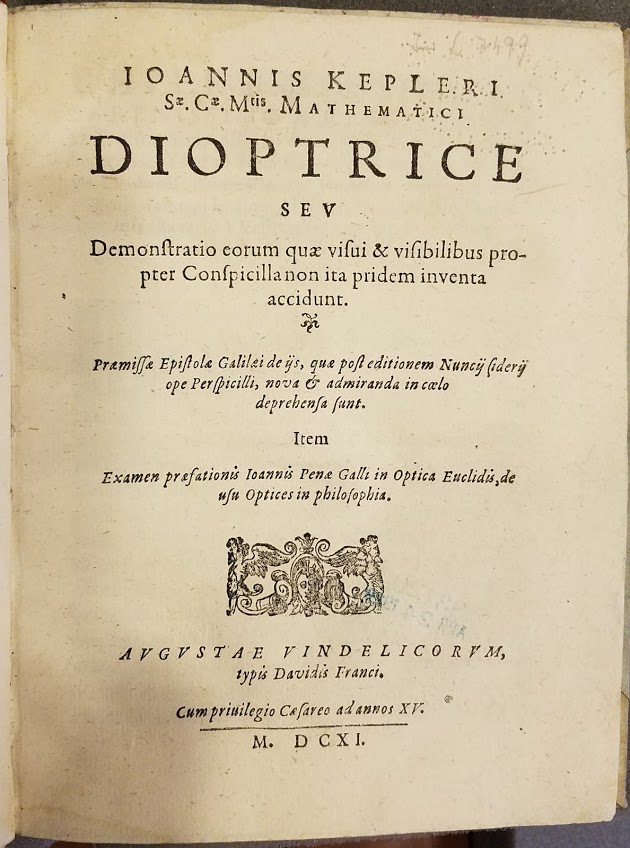
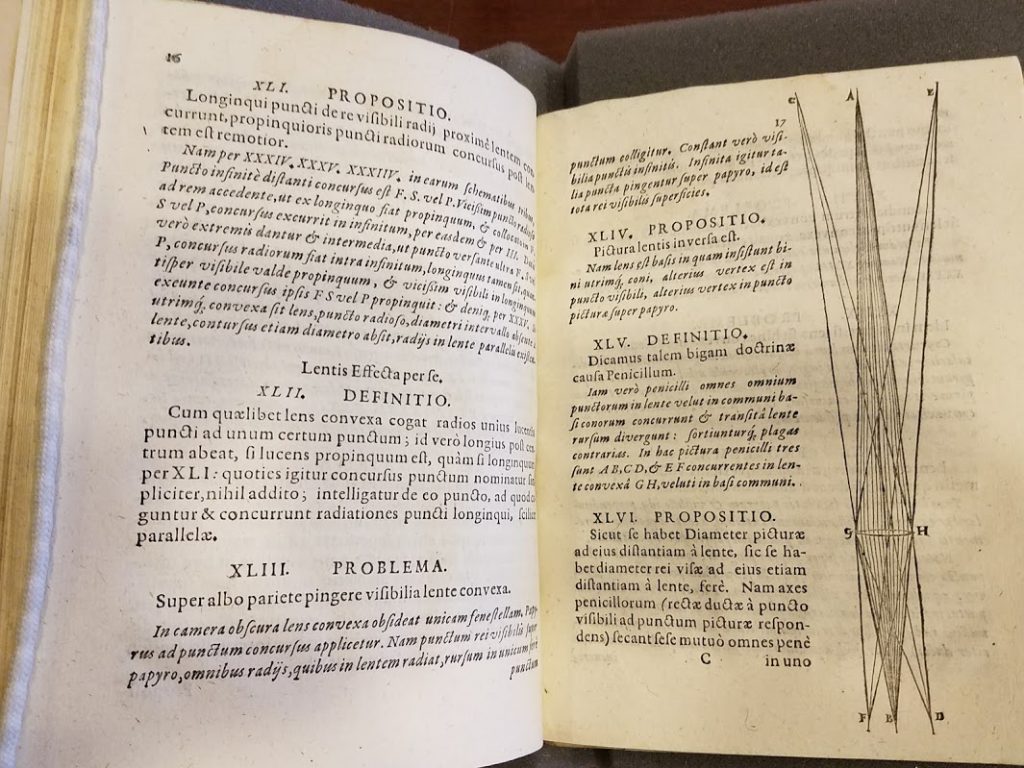
Next, there is Kepler’s Dioprice (published in 1611), which produced the first theoretical explanation of the Dutch telescope, guiding the discoveries of his contemporary, Galileo. Kepler’s theory of lenses played a crucial role in optics and were influential in the early history of telescopes, especially in the mid-17th century.

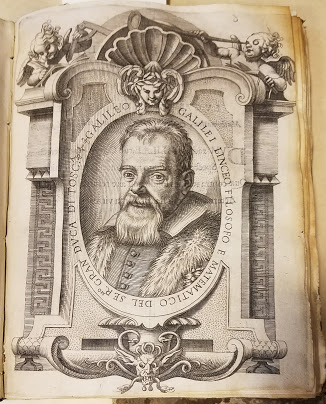
Finally, there is History and demonstrations concerning sunspots and their properties – Istoria e Dimostrazioni Intorno alle Macchie Solari, by Galileo Galilei, published Rome, 1613. In a 1611 book published by the Academy of the Lynx, the Jesuit astronomer Christoph Scheiner argued that sunspots are little planets circling the Sun like Venus. Galileo answered Scheiner with his 1613 book. Galileo’s detailed, full-page copperplate engravings set a new standard for presenting evidence about the Sun.
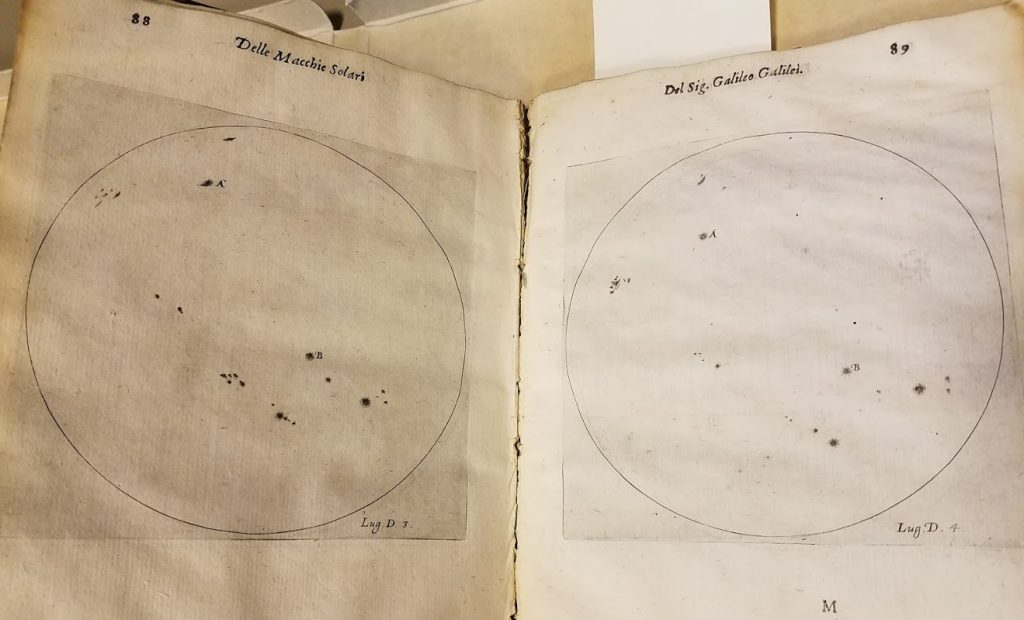
Galileo’s study of sunspots is a masterpiece of data visualization. The spots move together. They move slowly, each taking about a month to travel across the solar disk. Their shape is irregular; they form and disappear with irregular timing. The spots foreshorten as they approach the edge of the solar disk. All this proves they lie on or very near the surface, and are not little planets.
Conflicting ideas on the nature of sunspots reflected the basic split between the inflexibly philo-Aristotelian position of Scheiner, unable to forego the concept of an incorruptible heaven, and Galileo’s increasing acceptance of the new Copernican cosmology.
Reference in the Special Collections Department is available to all library customers through email and telephone requests. Please note that the department is open by appointment only within the hours listed here.
NASA created a quick guide about the solar eclipse.
You can find a free eclipse glasses pickup location here. Maryland State Library for the Blind and Physically Handicapped has glasses while supplies last.
Sources
Koestler, Arthur. The Sleepwalkers: a History of Man’s Changing Vision of the Universe. Penguin Books, 2014.
“Letters on Sunspots.” Galileo, 9 Jan. 2017, galileo.ou.edu/exhibits/letters-sunspots.
“Museo Galileo.” Galileo Portal – Museo Galileo, http://portalegalileo.museogalileo.it/egjr.asp?c=36304.